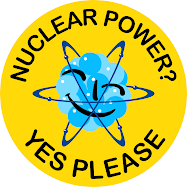[NOT EVEN CLOSE TO MY ORIGINAL CALCULATION WHICH WAS OFF BY A FACTOR OF 1,000 (not a million) - SEE COMMENTS AND CORRECTED POST BELOW - MY APOLOGIES FOR THE ERROR.]
In December 2007 Scientific American published a report on coal power plant radioactive releases and compared these with those from an operating nuclear energy station. To the surprise of many in the general public, coal station emissions are A LOT higher than an operating nuclear plant.
In December 2007 Scientific American published a report on coal power plant radioactive releases and compared these with those from an operating nuclear energy station. To the surprise of many in the general public, coal station emissions are A LOT higher than an operating nuclear plant.
In fact, the fly ash emitted by a power plant—a by-product from burning coal for electricity—carries into the surrounding environment 100 times more radiation than a nuclear power plant producing the same amount of energy.
High coal radiation release rates were also reported in a study / report from the Oak Ridge National Laboratory in the USA. In fact, the ORNL study found so much fissionable material (Uranium and Thorium) in coal station discharge, that consideration was given to recovering the material for use as fuel in nuclear energy stations.
But how much does a coal station release? From the ORNL report linked above:
According to the National Council on Radiation Protection and Measurements (NCRP), the average radioactivity per short ton of coal is 17,100 millicuries/4,000,000 tons, or 0.00427 millicuries/ton. This figure can be used to calculate the average expected radioactivity release from coal combustion.
Converting this to metric equates to about 0.174 MBq/ton (metric ton).
According to Wikipedia (and again converting to metric), about 6.14 billion metric tons of coal are burned per year.
Multiplying the two means that the radioactive release from annual coal combustion is 1.069 PBq/yr (peta-Becquerels or 1,069,000,000,000,000 Bq).
The nuclear accident in Japan has many reports of total radiation release. Several are listed in Wikipedia. To be VERY generous to the coal industry, lets take the largest airborne release I was able to find (Iodine and Caesium together) = 270 PBq. Then add the largest water release reported 27 PBq for a total of 297 PBq.
But the release continues... at a reported rate of 200 million Bq/h in September. At this rate the total release from the accident will double after 170,000 years. But clean-up and recovery efforts along with natural decay means that rate can not possibly be sustained.
But for my calculation, I will assume the release from Fukushima is double what has been reported or 600 PBq. This is totally unfair to science as well as the nuclear industry, but let's roll with it.
So to summarise:
Coal = 1.067 PBq/yr
Fukushima = 600 PBq (unjustifiably doubled by me)
Therefore: every 600 years worldwide coal combustion releases as much radiation as was released from the nuclear accident at Fukushima (in reality, it's more like every 300 years). Or in one typical lifetime, coal use will result in the release of around 20% of the activity released from the Fukushima accident. In addition:
- Coal stations are distributed worldwide
- Coal emission are unregulated for radioactivity and imposing regulations onto them now is almost impossible
- Fly ash is typically stored in open air basins that have been known to fail.














